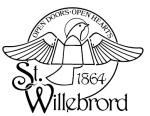Gestures, Postures, and Ritual Movements
Our worship and prayer are full of gestures, postures, and ritual movements. Dipping our fingers in the holy water font, blessing ourselves as we remember our baptism “in the name of the Father, the Son, and Holy Spirit,” and genuflecting or bowing as we enter our pew or pass the Sanctuary, altar and tabernacle – all of these are important reminders of who we are, and where we are.
Additionally, we stand, sit, kneel, and bow from the waist, or bow our heads at different moments in the celebration of the Eucharist. We make small crosses on our forehead, lips, and heart as we prepare to listen to the Gospel, asking, “may the words of the Gospel be on my mind, on my lips, and in my heart.” The prayer is not explicitly required of the congregation, but the sense of the gesture is similar to the words prayed by a priest or deacon who proclaims the Gospel.
During the profession of the Nicene or Apostles’ Creed, we bow in honor to the Incarnation of the Son of God when we say of Jesus, “who was conceived of the Holy Spirit and born of the Virgin Mary.” For many years the congregation was instructed to bow for these words only during the Christmas season, but with liturgical changes introduced in 2011, we have been instructed to bow at the above words every time we profess our faith.
During COVID restrictions, we stopped sharing the Sign of Peace with a handshake. Many people have resumed that practice, but others have adopted other gestures like a small bow toward others with hands folded in reverence. I adopted the practice of using the American Sign Language for “peace be with you.” You see me do it at every Mass at which I preside. I place my hands together in front of me, then rotate the hands and extend them out to the side. It is my preferred way for extending a sign of peace to someone who sees me from afar. Others will use the universal sign of the “V” with two fingers, while others use a wave, a smile, or other appropriate gestures in order to say “peace” to their neighbor.
I think that is important to teach the children, at the youngest age possible, how to do the above gestures and assume the appropriate postures at the right time. If a child is able to kneel and see above the pew, s/he should be taught and required to assume that posture with his parents. Many children are allowed to sit in the pew and play with toys, books, or to eat snacks. At the earliest age possible, children will adapt very well to being a participating member of the worshipping community. We must invite them, and include them, in every way possible. By doing so, we hope that they will discover the nearness of God in words and actions.
Peace, Fr. Andy
